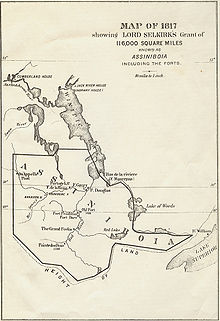
Back Red-River-Kolonie German Red River (kolonio) Esperanto مستعمرهنشین رد ریور Persian Red River Colony Finnish Colonie de la rivière Rouge French Kolonio di la Reda Fluvio IO Colonia di Red River Italian Koncesja Selkirka Polish Estabelecimento de Red River Portuguese Red River Colony SIMPLE
| Red River Colony | |||||||||||||
|---|---|---|---|---|---|---|---|---|---|---|---|---|---|
| British colony | |||||||||||||
| 1811–1870 | |||||||||||||
|
Flag | |||||||||||||
 Selkirk's land grant | |||||||||||||
| Capital | Upper Fort Garry | ||||||||||||
| Government | |||||||||||||
| • Type | Colony | ||||||||||||
| Governor | |||||||||||||
• 1812–1815 | Miles Macdonell | ||||||||||||
• 1859–1870 | William MacTavish | ||||||||||||
| History | |||||||||||||
• Established | 1811 | ||||||||||||
• Disestablished | 15 July 1870 | ||||||||||||
| |||||||||||||
The Red River Colony (or Selkirk Settlement), also known as Assiniboia, was a colonization project set up in 1811 by Thomas Douglas, 5th Earl of Selkirk, on 300,000 square kilometres (120,000 sq mi) of land in British North America. This land was granted to Douglas by the Hudson's Bay Company in the Selkirk Concession. It included portions of Rupert's Land, or the watershed of Hudson Bay, bounded on the north by the line of 52° N latitude roughly from the Assiniboine River east to Lake Winnipegosis. It then formed a line of 52° 30′ N latitude from Lake Winnipegosis to Lake Winnipeg, and by the Winnipeg River, Lake of the Woods and Rainy River.
West of the Selkirk Concession, it is roughly formed by the current boundary between Saskatchewan and Manitoba. These covered portions consisted of present-day southern Manitoba, northern Minnesota, and eastern North Dakota, in addition to small parts of eastern Saskatchewan, northwestern Ontario, and northeastern South Dakota.[1][2] The lands south of the 49th parallel north ceased to be a part of the Red River Colony following the signing of the Treaty of 1818, in which the United Kingdom agreed to cede this territory to the United States.
